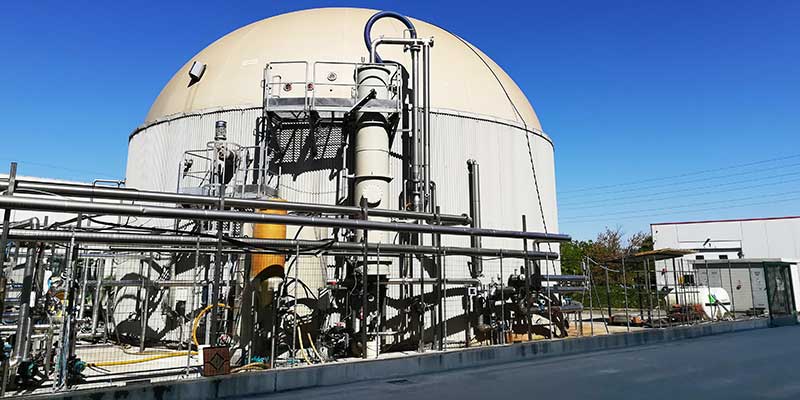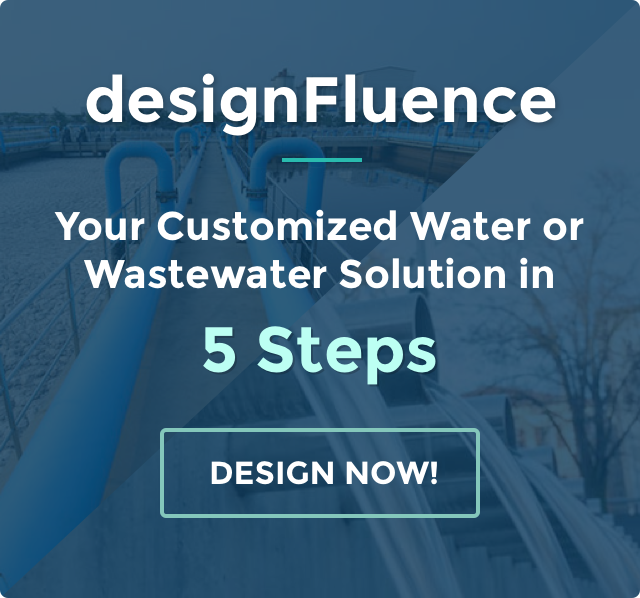Waste-to-Energy Solutions
Fluence can help you turn waste into a resource with cost-effective and sustainable technologies
In the past, industries that produced effluent with a high organic load usually flushed it away as wastewater. Now with anaerobic digestion it's possible to find value in what was once wasted. Why choose Fluence waste-to-energy (WtE) technologies? The benefits include:
- On-site production of renewable energy in the form of biogas, which decreases a company's carbon footprint
- Access to incentives
- Enhancement of products that otherwise have a modest value or even cost money to dispose of
- Production of a digestate suitable for agricultural use
- A significant reduction in the amount of sludge produced: up to 70% less than a flotation chain plus aerobic purifier
WtE Solutions Help Industries Add Value
All clients are different, and, consequently, they produce effluent with different characteristics. Before designing a plant, we analyze byproducts in our laboratory to determine their capacity to produce biogas. Fluence engineers then evaluate the potential solution in business terms, calculating capital costs, operating cost reductions, and return on investment.
Here are some examples of treatment processes designed for different industries.
Meat and Fish Processing
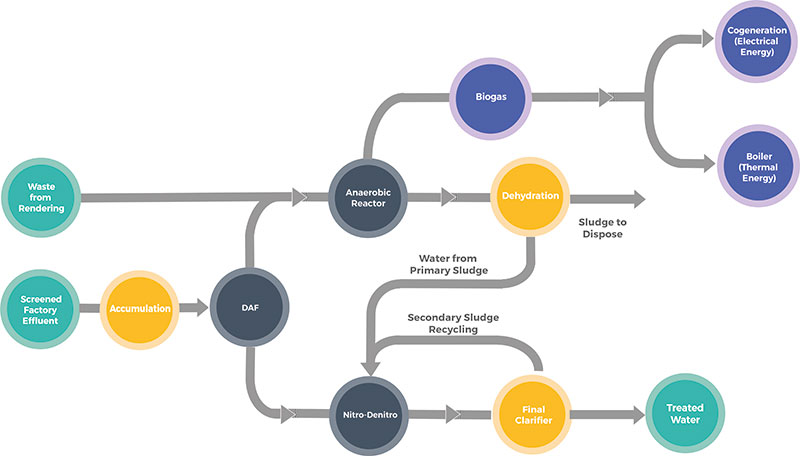
Wastewater from meat and seafood-processing operations can be highly contaminated with biochemical oxygen demand (BOD), nitrogen, and fat, oil, and grease (FOG). Fluence offers solutions that guarantee that discharge limits are met, that produce low quantities of sludge, and that recover maximum energy. A common treatment design consists of DAF pretreatment, followed by nitro-denitro to discharge the treated water, and an anaerobic digester to produce biogas.
See what happened when one of Italy's top chicken producers needed to increase production and lower costs. It turned to Fluence for a waste-to-energy upgrade to its existing WWTP. Fluence revamped the plant, building and activating an anaerobic digester and nitrification-denitrification system as the facility carried on its normal six-day-a-week operation schedule!
Dairy Processing
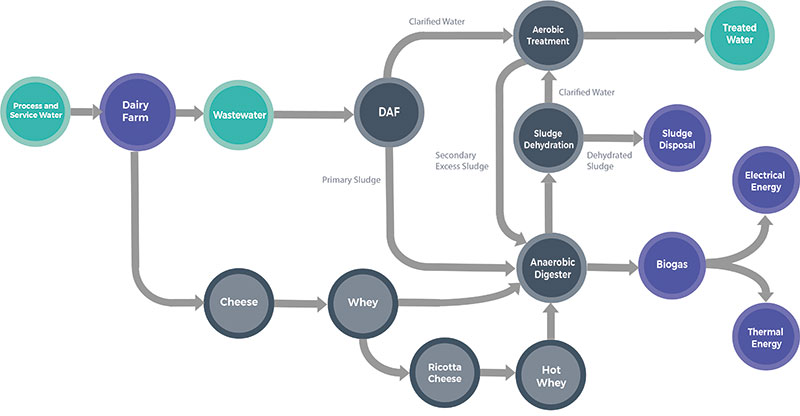
The dairy industry faces challenges when it comes to the disposal of many production byproducts, including whey, hot whey, buttermilk, cheese processing wastewater, and UF permeates from whey protein concentrate production. With our cost-effective solutions, wastewater and byproducts that have low value or that must be disposed of can create value through the generation of biogas in an anaerobic digester.
To get an idea of how anaerobic digestion can create value, a dairy processing plant in Italy provides a good example. When it needed to dispose of excess scotta-whey, a production byproduct, Fluence provided an anaerobic digestion step to its WWTP, and later, made adjustments to the process to handle increased volume. The plant now produces biogas to power operations, as well as liquid digestate, an excellent source of organic fertilizer.
Fruit Processing, Soft Drink, and Confectionery Industries
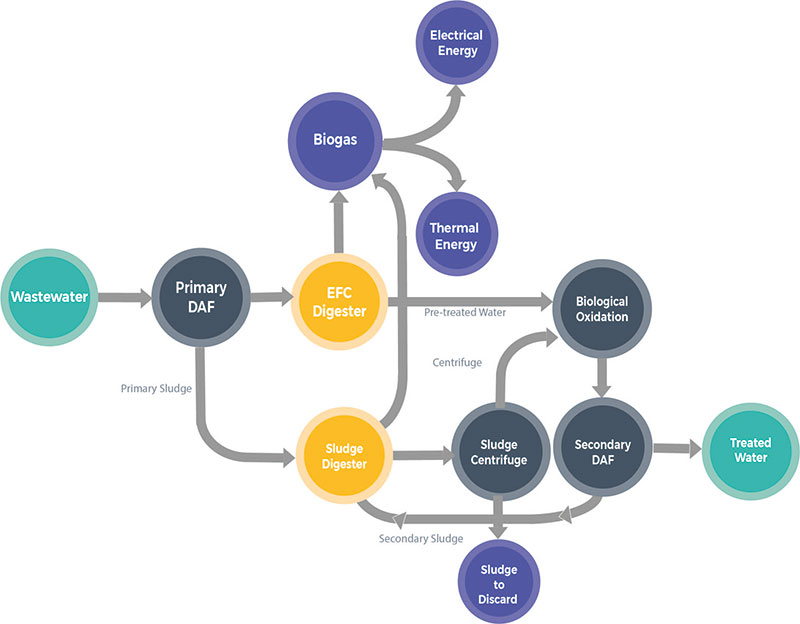
Confectionery industry wastewater is usually high in fats and sugars, which makes it a good candidate for anaerobic treatment: sugars with an external forced circulation (EFC) reactor, and fats with a CSTR digester.
When an Italian sweets manufacturer wanted to build an enhanced wastewater treatment plant with waste-to-energy technology, it turned to Fluence for a sustainable solution. Fluence created a hybrid system with both an EFC reactor and a CSTR digester, resulting in a reduction of COD from 9,600 mg/L to less than 80 mg/L, and nitrogen from 115 mg/L to less than 10 mg/L. Solid sludge was reduced by 70%.
Brewing
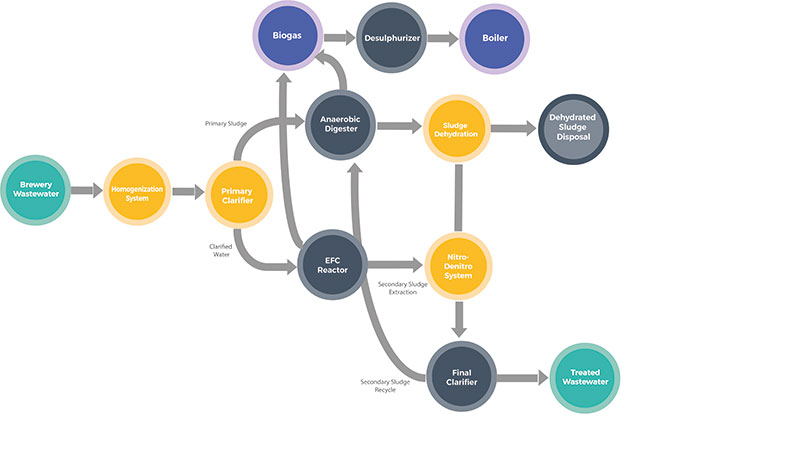
The brewing industry produces many waste products that can produce biogas, including liquid waste, sludge, spent grains, and exhausted yeast.
Fluence offers solutions for breweries to help reduce sludge and produce renewable energy in the form of biogas. One typical arrangement includes a continuous stirred-tank reactor (CSTR) to treat the primary sludge and exhausted yeast, and an external forced circulation (EFC) reactor to treat the wastewater. Both digesters produce thermal and electrical energy for the production process itself.
Paper and Pulp Processing
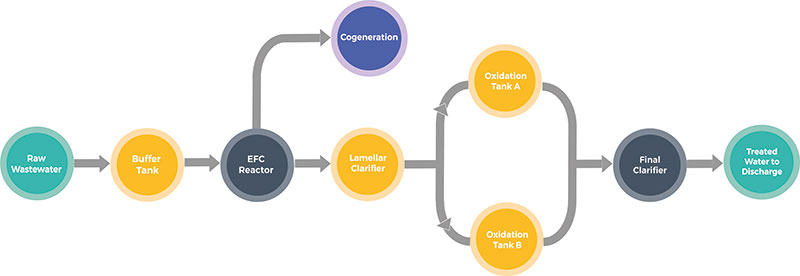
Wastewater generated by paper mills usually has a high organic load that makes it hard to meet discharge limits. Fluence offers two main treatment options: one with aerobic treatment only, consisting of an aeration basin equipped with an antibulking selector and a clarifier, and another one that includes an anaerobic reactor. The most suitable type of reactor is the external forced circulation (EFC) reactor, which is used for wastewater with organic pollution by soluble matter.
When a paper mill in Italy was having trouble meeting effluent standards, Fluence engineered and built plant upgrades based on its EFC reactor in less than five months, reusing some of the plant's existing equipment to save on capital expenditure. Since the new process went online, the plant has reduced its sludge waste volume by 8 tons a day and its energy consumption by 8,000 kilowatt hours a day. The changes ultimately reduced the facility's operating expenses as well.
What Are Waste-to-Energy Solutions?
To ensure the long-term sustainability of resources, waste-to-energy solutions treat wastewater and produce energy, converting what would otherwise be discarded as waste into a valuable resource. Fluence provides a variety of industries with cost-effective, closed-loop solutions to dispose of difficult wastewater and sludge while producing renewable energy.
Waste-to-Energy Resources
Featured Waste-to-Energy Technologies
Our engineers have developed some of the most efficient and cost-effective waste-to-energy technologies on the market.
Here are a few of our latest innovations.
Waste-to-energy treatment is custom-tailored to meet specific needs
Fluence has technologies that can be used alone or in tandem to operate independently or to complement an existing wastewater treatment system.
- External Forced Circulation Reactor (EFC): In this anaerobic process, granular sludge biomass recirculation occurs with an external pumping system. EFC is well suited for use in breweries and fruit processing plants, and in the pulp and paper industries.
- Anaerobic Digestion With Membranes (AnMBR): For substrates with low COD (<20,000 mg/L), when granular sludge technology is not applicable, it's possible to use AnMBR technology, a combination of anaerobic digestion and membrane bioreactor technology. AnMBR concentrates digestate without the use of thickeners, centrifuges, or dissolved air flotation (DAF). Digestate solids, which contain the active biomass, are concentrated and kept inside the digester while the liquid part -- which contains residual COD and potentially inhibitory substances like ammonia and chlorides -- is continuously moved away from the digester. This liquid part has practically no suspended solids. Using a bioreactor with the MBR membranes maximizes the effectiveness of the anaerobic process with a minimum space requirement.
- Anaerobic Digestion With Continuous Stirred Tank Reactor (CSTR): This process features complete mixing without recirculation of the effluent. It's best for the fish and meat processing industries, livestock wastewater, and excess sludge from biological treatment
- Anaerobic Digestion With Sludge Concentration: This complete mixed process, with anaerobic biomass recirculation, is best for dairy farms or with liquid wastes with COD of 40,000 mg/L or higher.
- Biogas Desulfurization: Biogas produced by the anaerobic treatment process can be rich in hydrogen sulfide, which must be removed before biogas can be used since it's harmful to cogenerators and boilers. Fluence engineers have developed a unique biogas desulfurization technology that doesn't use the common methods of blowing air into the digester dome or scrubbing the biogas with a caustic soda solution. Instead, it uses a synergic process involving the wet removal of the hydrogen sulfide coupled with auto-regeneration of the washing solution. This significantly lowers consumption of reagents, and subsequently, operating costs. Our solution is the most cost-effective on the market.
Aerobic treatments work with anaerobic processes for a complete solution
Fluence solutions help you remove nitrogen compounds to meet discharge limits.
- Nitrification-Denitrification System: Anaerobic digestion converts a large part of the organic carbon in biomass into biogas but leaves nitrogen content. In order to meet nitrogen permit limits, Fluence has developed a proprietary nitrification-denitrification process that doesn't require the addition of an organic carbon source. The process uses autotrophic bacteria to convert the nitrogen of the digestate into gaseous nitrogen without the use of chemicals, and without generating byproducts, allowing the client to reliably meet nitrogen discharge limits.
- Biological Oxidation: This biological aerobic treatment of wastewater takes place in a tank into which air is blown. In the tank, colonies of aerobic microorganisms (active sludge) consume oxygen as well as contaminants in the wastewater (COD, nitrogen, and phosphorous). Often, biological oxidation is used with nitrification-denitrification.
- Nitrosation: Fluence has also developed a proprietary nitrosation-denitrosation treatment process that can be used in cases of wastewater with very limited residual COD and/or high ammonia load (for example, the liquid fraction of digestates). Nitrosation partially converts ammonia into gaseous nitrogen using only two-thirds of the energy required by nitrification-denitrification, and it is three times faster (in other words, the required volumes are three times lower).
Processes prepare effluent for waste-to-energy treatment
Fluence solutions remove grease and solids before anaerobic digestion and help in sludge management.
- Dissolved Air Flotation (DAF): DAF is a clarification process used for the separation of solids, grease, and oils. The advantage of DAF systems lies in their ability to treat a wide range of suspended solids (fats, oil, grease) in water at a high rate of solids removal. DAF systems also are used for wastewater sludge thickening. DAF is best suited for effluents from meat, poultry, and fish processing, the dairy industry, and other food processing, as well as from the petroleum and pulp and paper industries.
- Flocculation and Sedimentation: The process is composed of three phases: coagulation, flocculation, and sedimentation.
- Coagulation is an operation that aggregates colloidal suspended solids and oils in wastewater, converting them from liquid to solid through the addition of specific chemicals (iron chloride, aluminum chloride, etc.)
- Flocculation is an operation that coalesces coagulated particles into flocs, which settle as sediment more quickly than the smaller particles do. The process takes place with the addition of organic polyelectrolytes (polymer molecules with electrolyte units).
- Sedimentation takes place in tanks called clarifiers, in which the upward speed of the water is lower than the sedimentation speed of the particles. The particles settle to the bottom of the clarifier, while the clarified water overflows from the top.
Why Work With Fluence?
Customized Engineering Solutions
Every customer has different needs and sometimes a standard solution won't do. Fluence offers tailor-made solutions to work around customers' needs, including space constraints, the need for unexpected upgrades, and more stringent water discharge limits. Fluence designs, engineers, and builds waste-to-energy and wastewater treatment plants with proprietary technologies and an experienced staff.
Smart Products
When time is limited, sometimes the best solution is a cost-effective, pre-engineered technology. Fluence has a wide range of pre-engineered and preassembled systems that can be up and running in record time. Examples are DAF systems, clarifiers, and potabilization systems.
Aftermarket and Service
Fluence doesn't abandon its customers after purchase. We offer after-sales process support on our designed plants, as well as service to existing municipal and industrial plants, such as ozonation and potabilization plants.
If your business is producing an effluent with a high organic load, contact the experts at Fluence to learn more about how you can capture value from waste.
Featured Waste-to-Energy Case Studies
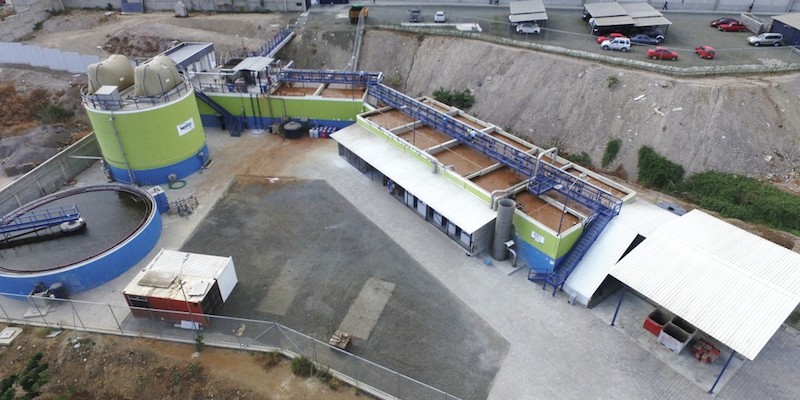
Waste-to-Energy Technology Helps Fish Processor Save on Operating Costs
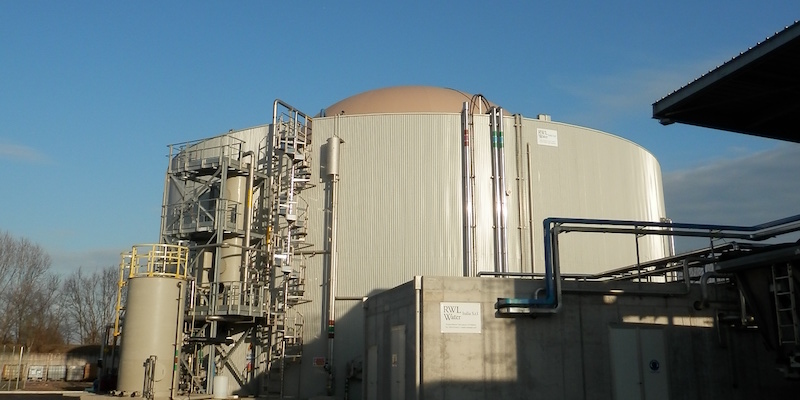
Sustainable Solutions for an Italian Biochemical Plant
